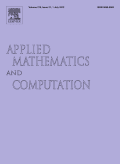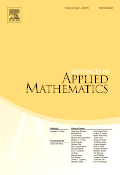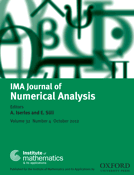
APPLIED MATHEMATICS AND COMPUTATION
Scope & Guideline
Exploring the Depths of Applied Mathematics
Introduction
Aims and Scopes
- Mathematical Modeling and Analysis:
The journal emphasizes the creation and analysis of mathematical models used to represent real-world phenomena, including dynamical systems, biological models, and economic systems. - Numerical Methods and Algorithms:
A significant focus is placed on the development and application of numerical methods for solving complex mathematical problems, including finite element methods, finite difference methods, and optimization algorithms. - Control Theory and Systems Engineering:
Research related to control systems, particularly in the context of nonlinear systems, adaptive control, and event-triggered control strategies, is a core area of the journal. - Computational Mathematics and Software Development:
The journal promotes studies that involve computational techniques and the development of software tools to facilitate mathematical problem-solving, including simulations and algorithm implementations. - Interdisciplinary Applications:
Papers often explore interdisciplinary applications of mathematics in fields such as engineering, physics, biology, finance, and social sciences, showcasing the versatility of mathematical applications.
Trending and Emerging
- Machine Learning and Data Science:
There is a growing trend of incorporating machine learning techniques in mathematical modeling and analysis, emphasizing data-driven approaches to solving complex problems. - Dynamic Systems and Control:
Research focusing on adaptive control, event-triggered control strategies, and synchronization of complex networks is becoming increasingly prevalent, reflecting the need for robust control mechanisms in dynamic environments. - Numerical Solutions for Fractional Differential Equations:
An emerging area of interest is the study of fractional differential equations, which are being increasingly applied in various fields, including physics and engineering, to model phenomena involving memory and hereditary properties. - Interdisciplinary Research Applications:
There is a notable increase in papers that apply mathematical theories to interdisciplinary fields such as economics, environmental science, and healthcare, reflecting a broader applicability of mathematical techniques. - Optimization Under Uncertainty:
The exploration of optimization problems under uncertainty, particularly in financial and operational contexts, is gaining traction, highlighting the importance of robust decision-making frameworks.
Declining or Waning
- Static Mathematical Models:
There has been a noticeable decline in the publication of papers focused solely on static models without consideration of dynamic factors or real-time data integration. - Purely Theoretical Mathematics:
Papers that focus exclusively on theoretical aspects of mathematics, without application to real-world problems or computational methods, are becoming less prominent in favor of more applied and computational research. - Traditional Optimization Techniques:
Classic optimization methods are seeing reduced interest as newer, more sophisticated algorithms, such as those based on machine learning and artificial intelligence, gain traction. - Discrete Mathematics in Isolation:
Studies centered on discrete mathematics that do not connect to broader computational or applied contexts are experiencing a decline, as the journal shifts toward more integrative and application-focused research.
Similar Journals

ESAIM-Mathematical Modelling and Numerical Analysis
Connecting Scholars to the Future of Mathematical ResearchESAIM-Mathematical Modelling and Numerical Analysis, published by EDP SCIENCES S A, is a prestigious open-access journal at the forefront of the fields of mathematical analysis, applied mathematics, computational mathematics, modeling, simulation, and numerical analysis. With an impressive Q1 ranking in multiple categories for 2023, the journal is recognized for its contribution to advanced research, particularly in areas that intertwine mathematical theory with practical applications. The journal’s ISSN is 2822-7840 and its E-ISSN is 2804-7214, showcasing its commitment to both traditional and digital dissemination of knowledge. Spanning from 1996 to 2024, ESAIM has established itself as a vital platform for scholars seeking to publish innovative research and engage with the latest advancements in the field. Researchers and practitioners can explore the journal’s content through various access options, fostering a collaborative environment for the sharing and development of new mathematical methodologies. Situated in France, ESAIM continues to attract an international readership, driving forward the global discourse in mathematical sciences.

ADVANCES IN APPLIED MATHEMATICS
Illuminating the Path of Mathematical DiscoveryADVANCES IN APPLIED MATHEMATICS, published by ACADEMIC PRESS INC ELSEVIER SCIENCE, is a prestigious journal that has served the mathematical community since 1980. With its ISSN 0196-8858 and E-ISSN 1090-2074, the journal is based in the United States, specifically in San Diego, CA. As a leading periodical in the field, it holds a notable Q2 ranking in Applied Mathematics and has been consistently ranked in the 43rd percentile among similar journals, illustrating its relevance and impact within the discipline. Although not an Open Access journal, ADVANCES IN APPLIED MATHEMATICS plays a crucial role in disseminating significant research findings, theoretical studies, and innovative applications of mathematics that address real-world problems. Researchers, professionals, and students alike will find valuable insights in its carefully curated publications, making it an essential resource for those looking to advance their understanding and application of mathematics.

COMPUTATIONAL & APPLIED MATHEMATICS
Transforming Complex Problems into Elegant SolutionsCOMPUTATIONAL & APPLIED MATHEMATICS, published by SPRINGER HEIDELBERG, serves as a premier platform for the dissemination of high-quality research and advancements in the fields of applied and computational mathematics. With an esteemed reputation bolstered by a Q2 ranking in both Applied Mathematics and Computational Mathematics categories, this journal delivers invaluable insights that cater to the scholarly community, including researchers, professionals, and students. It features rigorous peer-reviewed articles that cover a wide array of mathematical models, numerical algorithms, and their applications across various scientific and engineering domains. The journal has been in circulation since 2003 and remains relevant through its commitment to publishing cutting-edge research until 2024. Though not open access, its impact within the academic landscape is significant, with Scopus rankings placing it in the top quartiles of its fields. Whether you are seeking to stay updated on the latest findings or contribute your own work, COMPUTATIONAL & APPLIED MATHEMATICS is an essential resource for those committed to the advancement of mathematical sciences.

Mathematics in Applied Sciences and Engineering
Advancing innovation through mathematics and engineering.Mathematics in Applied Sciences and Engineering is a pioneering Open Access journal published by WESTERN LIBRARIES in Canada, dedicated to advancing the field of applied mathematics and its integration into engineering practices. With an E-ISSN of 2563-1926, this journal has been actively disseminating critical research since its inception in 2020, and aims to foster innovation and collaboration among researchers, professionals, and students alike. The journal excels in covering important topics within applied mathematics, modeling, and simulation, despite its current standing in the Q4 quartile for these categories according to the 2023 rankings, indicating significant opportunities for growth and contribution in these fields. Positioned in a competitive academic landscape—ranked #437 out of 635 in Applied Mathematics and #253 out of 324 in Modeling and Simulation—this outlet serves as an accessible platform for scholarly exchange, ensuring that emerging ideas and methodologies reach a broad audience while maintaining a commitment to academic integrity and quality.

Bulletin of the South Ural State University Series-Mathematical Modelling Programming & Computer Software
Transforming Ideas into Algorithms: Your Research HubThe Bulletin of the South Ural State University Series-Mathematical Modelling Programming & Computer Software is a distinguished academic journal focusing on the interdisciplinary fields of mathematical modeling, programming, and software development. Published by the SOUTH URAL STATE UNIVERSITY, SCIENTIFIC RESEARCH DEPARTMENT, this journal serves as a platform for the dissemination of innovative research findings, methodologies, and applications in computational mathematics and related disciplines. With its ISSN 2071-0216 and E-ISSN 2308-0256, it has garnered attention within the research community, reflected in its rankings within the Q4 quartile across multiple categories in 2023, including Computational Mathematics and Software. Although it operates under an open access model, the journal emphasizes the importance of high-quality, peer-reviewed content to advance research education and practice in the Russian Federation and beyond. Researchers, professionals, and students are encouraged to contribute and access valuable insights, fostering collaboration among disciplines spanning mathematical theory, computational methods, and software development.

Annals of Mathematical Sciences and Applications
Transforming Theoretical Insights into Real-World SolutionsAnnals of Mathematical Sciences and Applications, published by INT PRESS BOSTON, INC, stands as a prominent journal in the field of mathematical sciences, notably emphasizing the intersection of theoretical advancements and practical applications. Recognized for its commitment to disseminating innovative research, this journal serves as a pivotal platform for scholars, professionals, and students aiming to explore the diverse realms of applied mathematics, mathematical modeling, statistics, and computational methods. Though the journal does not currently offer an open access model, it provides crucial insights and fosters dialogue among the research community, contributing to the development and application of mathematical theories to real-world challenges. With its ISSN of 2380-288X and E-ISSN 2380-2898, the journal is positioned to be an essential resource for those seeking to advance their understanding and application of mathematics in various disciplines.

Applied Mathematics in Science and Engineering
Catalyzing Interdisciplinary Discoveries through Mathematics.Applied Mathematics in Science and Engineering is a prestigious academic journal published by TAYLOR & FRANCIS LTD, dedicated to presenting innovative research at the intersection of applied mathematics, science, and engineering disciplines. Since its inception as an Open Access platform in 2022, this journal has empowered researchers worldwide to disseminate their findings without barriers, enhancing knowledge-sharing among scholars, professionals, and students. Covering a wide range of topics, including but not limited to mathematical modeling, computational methods, and engineering applications, Applied Mathematics in Science and Engineering aims to foster interdisciplinary collaboration and advance the field through high-quality research articles. With a commitment to rigorous peer review and academic excellence, this journal serves as an essential resource for anyone seeking to stay at the forefront of applied mathematics in contemporary scientific inquiry.

Applied and Computational Mathematics
Connecting Theory and Practice in Mathematics for Global ImpactApplied and Computational Mathematics is a premier journal dedicated to the dissemination of innovative research in the fields of applied mathematics and computational mathematics. Published by the MINISTRY COMMUNICATIONS & HIGH TECHNOLOGIES REPUBLIC AZERBAIJAN, this journal offers a prominent platform for scholars and practitioners worldwide, boasting an impressive Q1 category ranking in applied mathematics and Q2 in computational mathematics for 2023. With an excellent Scopus ranking placing it in the 96th percentile for both categories, it highlights the high quality and global impact of its published work. The journal spans a wide range of topics, ensuring it remains relevant to current and emerging trends in both theoretical and applied contexts. Access to its articles is streamlined through open channels, promoting collaboration and knowledge sharing among researchers. Applied and Computational Mathematics is pivotal for advancing the discipline and supporting the academic community's growth, making it an essential resource for researchers, professionals, and students alike.

IMA JOURNAL OF NUMERICAL ANALYSIS
Advancing the Frontiers of Numerical MethodsIMA Journal of Numerical Analysis, published by Oxford University Press, stands as a premier platform for cutting-edge research in the field of numerical analysis, exemplifying the latest advancements and methodologies in applied, computational, and general mathematics. Since its inception in 1981, this esteemed journal has continually contributed to the academic community by publishing high-quality, peer-reviewed articles that foster innovation and collaboration among researchers. With an impressive Q1 ranking across multiple categories, including Applied Mathematics and Computational Mathematics, it plays a crucial role in disseminating knowledge, as indicated by its Scopus rankings which place it in the top 25% of journals within its field. Although the journal is not open access, it remains a vital resource for academics, professionals, and students eager to engage with the ongoing evolution of numerical methods. By serving as a conduit for novel ideas and rigorous research, the IMA Journal of Numerical Analysis ensures that its contributors and readers are at the forefront of this dynamic discipline.

BOLETIN DE LA SOCIEDAD MATEMATICA MEXICANA
Exploring the Depths of Mathematical KnowledgeBOLETIN DE LA SOCIEDAD MATEMATICA MEXICANA, published by Springer International Publishing AG, is a pivotal journal in the field of mathematics, particularly recognized for its contributions to the miscellaneous mathematics category, holding a commendable Q2 ranking as of 2023. With an ISSN of 1405-213X and an E-ISSN of 2296-4495, the journal serves as a platform for disseminating high-quality research and innovations from both national and international scholars. Operating from Switzerland, the journal encompasses a broad range of topics within mathematics, supporting the development and communication of mathematical knowledge. Although it is not open access, it remains a respected source for researchers, professionals, and students seeking to deepen their understanding of mathematical concepts and applications. Published continuously and rigorously since its converged years, BOLETIN DE LA SOCIEDAD MATEMATICA MEXICANA plays a crucial role in advancing mathematical discourse and collaboration across disciplines.